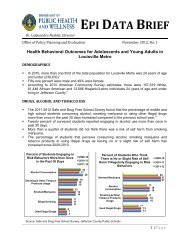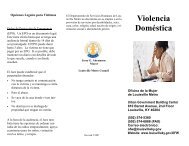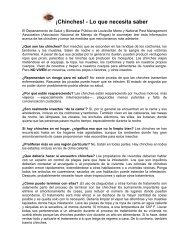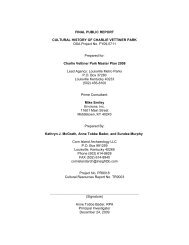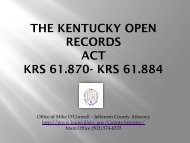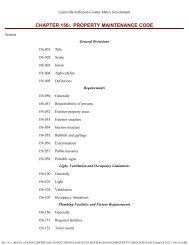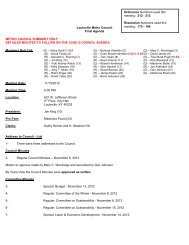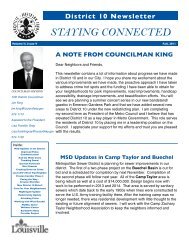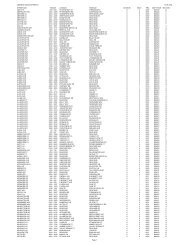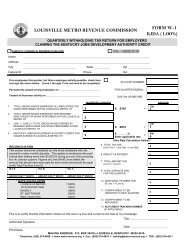Closing the Gap in 3rd Grade Reading Levels
Closing the Gap in 3rd Grade Reading Levels
Closing the Gap in 3rd Grade Reading Levels
Create successful ePaper yourself
Turn your PDF publications into a flip-book with our unique Google optimized e-Paper software.
Education Week Vol. 27, Issue 36, Pages 23, 25<br />
<strong>Clos<strong>in</strong>g</strong> <strong>the</strong> <strong>Gap</strong> <strong>in</strong> <strong>3rd</strong> <strong>Grade</strong><br />
Read<strong>in</strong>g <strong>Levels</strong><br />
Lessons from Three Inner City Elementary Schools<br />
By Rhonda H. Lauer<br />
For years, we have known that children who read<br />
at grade level by <strong>3rd</strong> grade are more likely to<br />
graduate from high school. High school graduates,<br />
<strong>in</strong> turn, are more likely to pursue fur<strong>the</strong>r<br />
education and be employed, with higher <strong>in</strong>comes and<br />
better health, than <strong>the</strong>ir peers who drop out. But many<br />
of <strong>the</strong> nation’s m<strong>in</strong>ority and disadvantaged children fail<br />
to achieve early academic success because, all too often,<br />
<strong>the</strong>y are already beh<strong>in</strong>d when <strong>the</strong>y start k<strong>in</strong>dergarten. The<br />
deficit is too vast to overcome <strong>in</strong> just a few years.<br />
As a lifelong educator, I cannot accept that some<br />
children’s dest<strong>in</strong>ies are set by age 9. In 2002, <strong>the</strong><br />
organization I lead, Foundations, began work<strong>in</strong>g with<br />
<strong>the</strong> Philadelphia school district <strong>in</strong> three urban elementary<br />
schools where 98 percent of <strong>the</strong> students are African-<br />
American and liv<strong>in</strong>g <strong>in</strong> poverty. At <strong>the</strong> time, <strong>the</strong>se were<br />
among Philadelphia’s lowest-perform<strong>in</strong>g schools. S<strong>in</strong>ce<br />
<strong>the</strong>n, <strong>the</strong> percentage of <strong>3rd</strong> graders meet<strong>in</strong>g targets for<br />
read<strong>in</strong>g <strong>in</strong> <strong>the</strong>se schools has <strong>in</strong>creased, from 33.4 percent<br />
<strong>in</strong> 2002 to 44.4 percent <strong>in</strong> 2007, catch<strong>in</strong>g <strong>the</strong>m up to<br />
<strong>the</strong>ir counterparts at o<strong>the</strong>r district schools.<br />
How have we narrowed <strong>the</strong> gap and, more<br />
importantly, how can we narrow it even more?<br />
Here are seven suggestions:<br />
• Establish a quality <strong>in</strong>structional program. All<br />
three schools follow <strong>the</strong> Philadelphia district’s core<br />
curriculum, which was implemented <strong>in</strong> 2003. Adher<strong>in</strong>g<br />
to a course of study that is consistent across schools<br />
is vital, because more than a third of Philadelphia<br />
schoolchildren change schools each year. Guided read<strong>in</strong>g<br />
is one staple of <strong>the</strong> core curriculum. Each day, teachers<br />
work with small groups of students, observ<strong>in</strong>g, guid<strong>in</strong>g,<br />
and encourag<strong>in</strong>g <strong>the</strong>m as <strong>the</strong>y read texts matched to <strong>the</strong>ir<br />
level. Ano<strong>the</strong>r key element <strong>in</strong> our schools is Systematic<br />
Instruction <strong>in</strong> Phoneme Awareness, Phonics, and<br />
“Adher<strong>in</strong>g to a course of<br />
study that is consistent across<br />
schools is vital.”<br />
Sight Words, or SIPPS, a phonics-awareness program<br />
that teachers <strong>in</strong> <strong>the</strong> early grades use for small-group<br />
<strong>in</strong>struction several times a week.<br />
• Take advantage of <strong>the</strong> modern child’s aff<strong>in</strong>ity for<br />
technology. A comprehensive survey by <strong>the</strong> National<br />
Center for Education Statistics found that <strong>in</strong> 2003, 66<br />
percent of children <strong>in</strong> nursery school were computer<br />
users, as were 80 percent of those <strong>in</strong> k<strong>in</strong>dergarten.<br />
Although many parents and educators bemoan such<br />
statistics, we know that children who use technology to<br />
read are more often those who read every day. Beg<strong>in</strong>n<strong>in</strong>g<br />
<strong>in</strong> 2nd grade, all our schools use a computer-assisted<br />
tutorial, SuccessMaker, to supplement traditional read<strong>in</strong>g<br />
<strong>in</strong>struction. It offers standards-based lessons focus<strong>in</strong>g<br />
on word identification, read<strong>in</strong>g comprehension, and<br />
vocabulary build<strong>in</strong>g. Students progress at <strong>the</strong>ir own pace,<br />
with sessions tailored to <strong>the</strong>ir needs. One school also<br />
uses <strong>in</strong> grades K-2 <strong>the</strong> LeapPad program, a multisensory<br />
technology and learn<strong>in</strong>g system that creates <strong>in</strong>dividual<br />
learn<strong>in</strong>g paths for each child based on read<strong>in</strong>g ability.<br />
• Use data as a strategy to drive <strong>in</strong>struction, not<br />
merely as a record-keep<strong>in</strong>g device. Each of our three<br />
schools houses a dedicated data room where walls are<br />
l<strong>in</strong>ed with easy-to-read charts and graphs depict<strong>in</strong>g<br />
read<strong>in</strong>g levels for each grade, class, and student. Upon<br />
enter<strong>in</strong>g <strong>the</strong>se rooms, teachers and adm<strong>in</strong>istrators can<br />
see—<strong>in</strong> color-coded reality—<strong>the</strong> overall challenges fac<strong>in</strong>g<br />
<strong>the</strong>m, as well as which students require early <strong>in</strong>tervention<br />
and <strong>in</strong>tensive read<strong>in</strong>g assistance.
“We need to reach children<br />
earlier and engage a variety<br />
of resources to prepare <strong>the</strong>m<br />
mentally and physically for<br />
school.”<br />
• Provide extra support for <strong>the</strong> teachers and<br />
caregivers of disadvantaged youths. Many students<br />
<strong>in</strong> our schools are be<strong>in</strong>g raised by s<strong>in</strong>gle parents or<br />
grandparents who may not be able to make education<br />
a top priority. At our schools, literacy workshops,<br />
monthly parent meet<strong>in</strong>gs, home and school associations,<br />
and numerous o<strong>the</strong>r special events offer families<br />
extra encouragement to participate <strong>in</strong> <strong>the</strong>ir children’s<br />
education.<br />
Teachers of disadvantaged youths need a boost as<br />
well. Each of our elementary schools has a schoolbased<br />
teacher-leader focused on literacy who, <strong>in</strong> turn, is<br />
supported by a literacy consultant. These consultants do<br />
whatever it takes to promote read<strong>in</strong>g achievement: assist<br />
<strong>in</strong> classrooms, model lessons, coach teachers, facilitate<br />
professional development, or o<strong>the</strong>r tasks.<br />
• Engage <strong>the</strong> entire community. Underserved youths<br />
require extra attention not only from <strong>the</strong>ir schools,<br />
but also from <strong>the</strong>ir communities. In our Philadelphia<br />
schools, older adults tra<strong>in</strong>ed to help struggl<strong>in</strong>g readers<br />
work <strong>in</strong> classrooms and provide one-on-one read<strong>in</strong>g<br />
<strong>in</strong>struction throughout <strong>the</strong> year. Neighborhood churches<br />
and community centers also sponsor ongo<strong>in</strong>g tutor<strong>in</strong>g<br />
sessions that focus on fluency, comprehension, and<br />
vocabulary build<strong>in</strong>g.<br />
• Start early. We must <strong>in</strong>tervene earlier <strong>in</strong> children’s<br />
lives, before <strong>the</strong>y enter school, when <strong>the</strong>ir bra<strong>in</strong>s are<br />
grow<strong>in</strong>g <strong>the</strong> fastest. We must provide <strong>the</strong>m with quality<br />
preschools, proper nutrition, and regular checkups. One<br />
of <strong>the</strong> Philadelphia schools houses an on-site day-care<br />
center as well as a preschool, so that local children can<br />
enter k<strong>in</strong>dergarten healthy, eager, and ready to learn.<br />
Many more such programs are needed.<br />
• Make school fun aga<strong>in</strong>. Our schools use a variety<br />
of <strong>in</strong>itiatives to help students enjoy learn<strong>in</strong>g, and<br />
read<strong>in</strong>g <strong>in</strong> particular. On “Pajama Read Night” <strong>in</strong> <strong>the</strong><br />
fall, children and <strong>the</strong>ir parents return to school <strong>in</strong> <strong>the</strong><br />
even<strong>in</strong>g dressed <strong>in</strong> pajamas, with pillows and stuffed<br />
animals, to read toge<strong>the</strong>r and enjoy milk and cookies.<br />
The “One Book, One School” program helps ma<strong>in</strong>ta<strong>in</strong><br />
excitement for read<strong>in</strong>g dur<strong>in</strong>g <strong>the</strong> f<strong>in</strong>al month of school,<br />
when energy and enthusiasm often lag. Every child <strong>in</strong> <strong>the</strong><br />
school receives a copy of <strong>the</strong> same title—<strong>in</strong> pop-up form<br />
for k<strong>in</strong>dergartners, and early readers or novels for older<br />
children. Teachers <strong>in</strong>corporate <strong>the</strong> text and its <strong>the</strong>mes<br />
<strong>in</strong>to lessons, and <strong>the</strong> school sponsors related field trips,<br />
parades, and fairs. Students at all three elementary schools<br />
also participate <strong>in</strong> an annual spell<strong>in</strong>g bee.<br />
The students <strong>in</strong> our three elementary schools<br />
have made great progress, but many enter<br />
k<strong>in</strong>dergarten at such a disadvantage that even <strong>the</strong><br />
best programs and <strong>the</strong> most motivated teachers<br />
cannot catch <strong>the</strong>m up. To make a greater impact, we need<br />
to reach children earlier and engage a variety of resources<br />
to prepare <strong>the</strong>m mentally and physically for school. Once<br />
<strong>the</strong>y arrive, we must provide <strong>the</strong>m with data-driven,<br />
literacy-focused programs that employ technology and<br />
community supports.<br />
We also need to make school fun for <strong>the</strong>m, so that<br />
<strong>the</strong>y have someth<strong>in</strong>g to look forward to each day. With<br />
today’s emphasis on test<strong>in</strong>g, many <strong>in</strong>ner-city schools<br />
cannot devote time to art, music, and gym, even though<br />
children at <strong>the</strong>se schools are <strong>the</strong> ones who need <strong>the</strong><br />
biggest <strong>in</strong>centive to come to school. If we do not restore<br />
<strong>the</strong> fun to learn<strong>in</strong>g, <strong>the</strong>y will view school only as work.<br />
And some, particularly struggl<strong>in</strong>g readers with <strong>in</strong>adequate<br />
family supports, may decide to skip it altoge<strong>the</strong>r.<br />
Rhonda H. Lauer, a former school super<strong>in</strong>tendent, pr<strong>in</strong>cipal,<br />
and teacher, is <strong>the</strong> chief executive officer of Foundations<br />
Inc., a nonprofit organization based <strong>in</strong> Moorestown, N.J.,<br />
whose mission is to improve educational opportunities for<br />
underserved youths.




